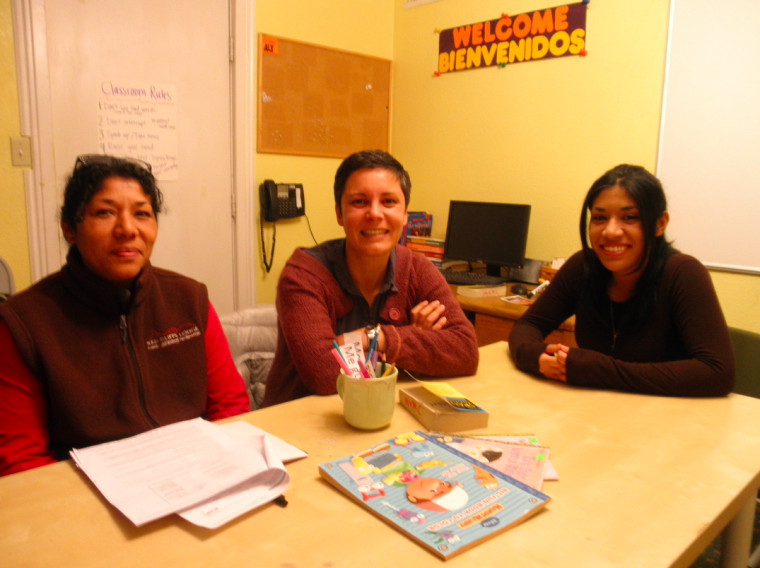Some information may be outdated.
Learning English has given Raul Felipe Cervantes a foothold that has made him more employable.
Though he still requires the help of a translator for some interactions, the Moab Valley Multicultural Center’s English classes have given Cervantes enough of a command of the language to communicate with his co-workers at Red Cliffs Lodge and to use the two-way radio, said Cervantes’ friend and co-worker, Kheyla Tanner.
“I’m so proud to see he’s now putting his notes in English, he’s reading, he can answer the radio,” said Tanner, who also works as an English teacher at the Moab Valley Multicultural Center.
Since the Moab Valley Multicultural Center was founded in 2007 they have offered English as a Second Language (ESL) classes. But in the coming months they plan to revamp the class structure to make it more institutionalized and permanent, two qualities that have been lacking in the past.
According to 2012 census data, 10-percent of Grand County’s population are Hispanic and 10.5-percent of families in the county speak a language other than English at home.
Trisha Hedin, the director of Arches Adult Education Center, which partners with the Moab Valley Multicultural Center for the ESL classes, and Alice Verney, the new Volunteers in Service to America (VISTA) volunteer coordinating the ESL program, both believe that Spanish is the language spoken in most of those homes.
“There has always been a need for English classes here in the community,” Verney said.
Though the Moab Area Multicultural Center is open to people of any culture, most of their work is centered around Moab’s Latino population.
“The student context that we deal with is primarily Latino Mexican,” Verney said. “A lot of them work in the hotels and restaurants in town. They can’t communicate with their boss, they can’t communicate to their kids’ teachers, they can’t communicate to the doctor.”
Cheryl Covey, the director of marketing at the Best Western Plus Canyonlands Inn, agreed that communicating with non-English speaking employees is a challenge for many of Moab’s employers.
“There is definitely a communications barrier when training and when complications arise,” she said. “If there’s not a non-bilingual person, to be able to get through, sometimes things aren’t done properly because the communication barrier is there. I personally think English classes would be a huge benefit.”
“Our goal is to make people’s lives better with both languages. We want to empower people, and language is a major way to empower people to help themselves,” said Rhiana Medina, the director of the Moab Valley Multicultural Center.
Unlike the VISTA volunteers that preceded her, Verney has specialized training and experience in teaching ESL courses. Training that she and her supervisors hope will ensure the continuity of the Moab Valley Multicultural Center’s ESL program.
“Our goal with Alice is that she will put something in place that will be there long-term,” said Hedin. Hedin made Verney available to the Moab Valley Multicultural Center through Arches Adult Education Center as part of the organizations’ partnership.
In the past the Moab Valley Multicultural Center’s English classes have been sporadic. Some of the classes have had good initial participation, but success has been limited because, the curriculum was based on volunteers in the community who taught out of a textbook, and because few students stayed with the program.
The problem with having volunteers as teachers was that often the volunteers had no experience teaching, and few of the volunteers could commit to the length of the course.
The multicultural center has sought to remedy this issue by hiring two teachers, Kheyla Tanner and her daughter Kheylita Tanner. Verney has been working to train the two women in ESL education, and together they are working on a curriculum designed to fit the specific needs of the non-English speaking Moab community.
“The books didn’t seem to click as much. With Alice’s approach it is going to be more based off their lives,” said Kheylita Tanner.
Kheyla Tanner believes the problem of attendance is more complex. Many in Moab’s Latino community dropped out of school at an early age, and thus have trouble reading and writing in any language. This can make trying to learn English difficult and frustrating, thus many students come to one or two classes then give up.
“What has happened in the past is they get discouraged very quickly,” Kheyla Tanner said.
The other problem in maintaining participation is a lack of support within the Spanish-speaking community. Cervantes found that many people would make fun of him for the mistakes he made while trying to practice speaking English. This embarrassment led to him using his English less and less.
Verney and the Tanners hope to push back against this culture both by creating a supportive classroom environment, and by showing the community through example the benefits of becoming proficient in English. They hope that by seeing people like Cervantes taking these classes, and seeing the improvements it brings to their lives and careers, ESL class will become normalized.
“One thing I believe in is that whatever happens outside the classroom has to be brought into the classroom to have a meaningful class,” Verney said.
Though the dates, times and curriculum of the ESL classes have yet to be set, the Moab Valley Multicultural Center is already trying to drum up interest.
There will be a community meeting for anyone interested in learning English or learning about the program from 6:30 to 7:30 p.m. on Monday, Nov. 18 at the St. Francis Episcopal Church on Kane Creek Blvd. Verney also encouraged anyone interested in learning English to call the Moab Valley Multicultural Center for information.
Appreciate the coverage? Help keep local news alive.
Chip in to support the Moab Sun News.





